فهرست مطالب

Iranian journal of fuzzy systems
Volume:8 Issue: 1, feb 2011
- تاریخ انتشار: 1390/01/08
- تعداد عناوین: 11
-
-
Page 1Logistic regression models are frequently used in clinical research and particularly for modeling disease status and patient survival. In practice, clinical studies have several limitations For instance, in the study ofra re diseases or due ethical considerations, we can only have small sample sizes. In addition, the lack ofs uitable and advanced measuring instruments lead to non-precise observations and disagreements among scientists in defining disease criteria have led to vague diagnosis. Also, specialists often report their opinion in linguistic terms rather than numerically. Usually, because oft hese limitations, the assumptions oft he statistical model do not hold and hence their use is questionable. We therefore need to develop new methods for modeling and analyzing the problem. In this study, a model called the “fuzzy logistic model” is proposed for the case when the explanatory variables are crisp and the value ofthe binary response variable is reported as a number between zero and one (indicating the possibility ofh aving the property). In this regard, the concept of“possibilistic odds” is also introduced. Then, the methodology and formulation of this model is explained in detail and a linear programming approach is use to estimate the model parameters. Some goodness-of-fit criteria are proposed and a numerical example is given as an example.
-
Page 19The concept of an L-bornology is introducedandthe theory of L-bornological spaces is being developed. In particular the lattice of all L-bornologies on a given set is studiedandbas ic properties of the category of L-bornological spaces andb oundedm appings are investigated.
-
Page 29A ood warning system is a non-structural measure for ood mit- igation. Several parameters are responsible for ood related disasters. This work illustrates an ordered intuitionistic fuzzy analysis that has the capability to simulate the unknown relations between a set of meteorological and hydro- logical parameters. In this paper, we rst de ne ordered intuitionistic fuzzy soft sets and establish some results on them. Then, we de ne similarity mea- sures between ordered intuitionistic fuzzy soft (OIFS) sets and apply these similarity measures to ve selected sites of Kerala, India to predict potential flood.
-
Page 41We study the problem of reconstructing binary images from four projections data in a fuzzy environment. Given the uncertainly projections,w e want to find a binary image that respects as best as possible these projections. We provide an iterative algorithm based on fuzzy integer programming and linear membership functions.
-
Page 49We are concerned with the development of a k−step method for the numerical solution of fuzzy initial value problems. Convergence and stability of the method are also proved in detail. Moreover, a specific method of order 4 is found. The numerical results show that the proposed fourth order method is efficient for solving fuzzy differential equations.
-
Page 65The aim of this paper is to introduce the notion of fuzzy homomorphism and fuzzy isomorphism between two n-ary hypergroups and to extend the fuzzy results of fundamental equivalence relations to n-ary hypergroups. We study some of their properties and prove the decomposition theorems for fuzzy homomorphism and fuzzy isomorphism.
-
Page 77In this paper, we propose the concepts of fuzzifying closure systems and Birkhoff fuzzifying closure operators. In the framework of fuzzifying mathematics, we find that there still exists a one to one correspondence between fuzzifying closure systems and Birkhoff fuzzifying closure operators as in the case of classical mathematics. In the aspect of category theory, we prove that the category of fuzzifying closure system spaces is isomorphic to the category of Birkhoff fuzzifying closure spaces. In addition, we obtain an important result that the category of fuzzifying closure spaces and that of fuzzifying closure system spaces can be both embedded in the category of Birkhoff I-closure spaces. Finally, using fuzzifying closure systems of the paper, we introduce a set of separation axioms in fuzzifying closure system spaces, which offer a try how to research the properties of spaces by fuzzifying closure systems.
-
Page 95In this paper, we define prime (semiprime) hyperideals and prime (semiprime) fuzzy hyperideals of semihypergroups. We characterize semihypergroups in terms of their prime (semiprime) hyperideals and prime (semiprime) fuzzyh yperideals.
-
Page 113We present some connections between the max-min general fuzzy automaton theory and the hyper structure theory. First, we introduce a hyper BCK-algebra induced by a max-min general fuzzy automaton. Then, we study the properties of this hyper BCK-algebra. Particularly, some theorems and results for hyper BCK-algebra are proved. For example, it is shown that this structure consists of different types of (positive implicative) commutative hyper K-ideals. As a generalization, we extend the definition of this hyper BCK-algebra to a bounded hyper K-algebra and obtain relative results.
-
Page 135In this paper, we introduce the concepts ofnor m and inner product on fuzzy linear spaces over fuzzy fields and discuss some fundamental properties.
-
Page 145In this paper, various elementary properties of vague rings are obtained. Furthermore, the concepts of vague subring, vague ideal, vague prime ideal and vague maximal ideal are introduced, and the validity of some relevant classical results in these settings are investigated.

